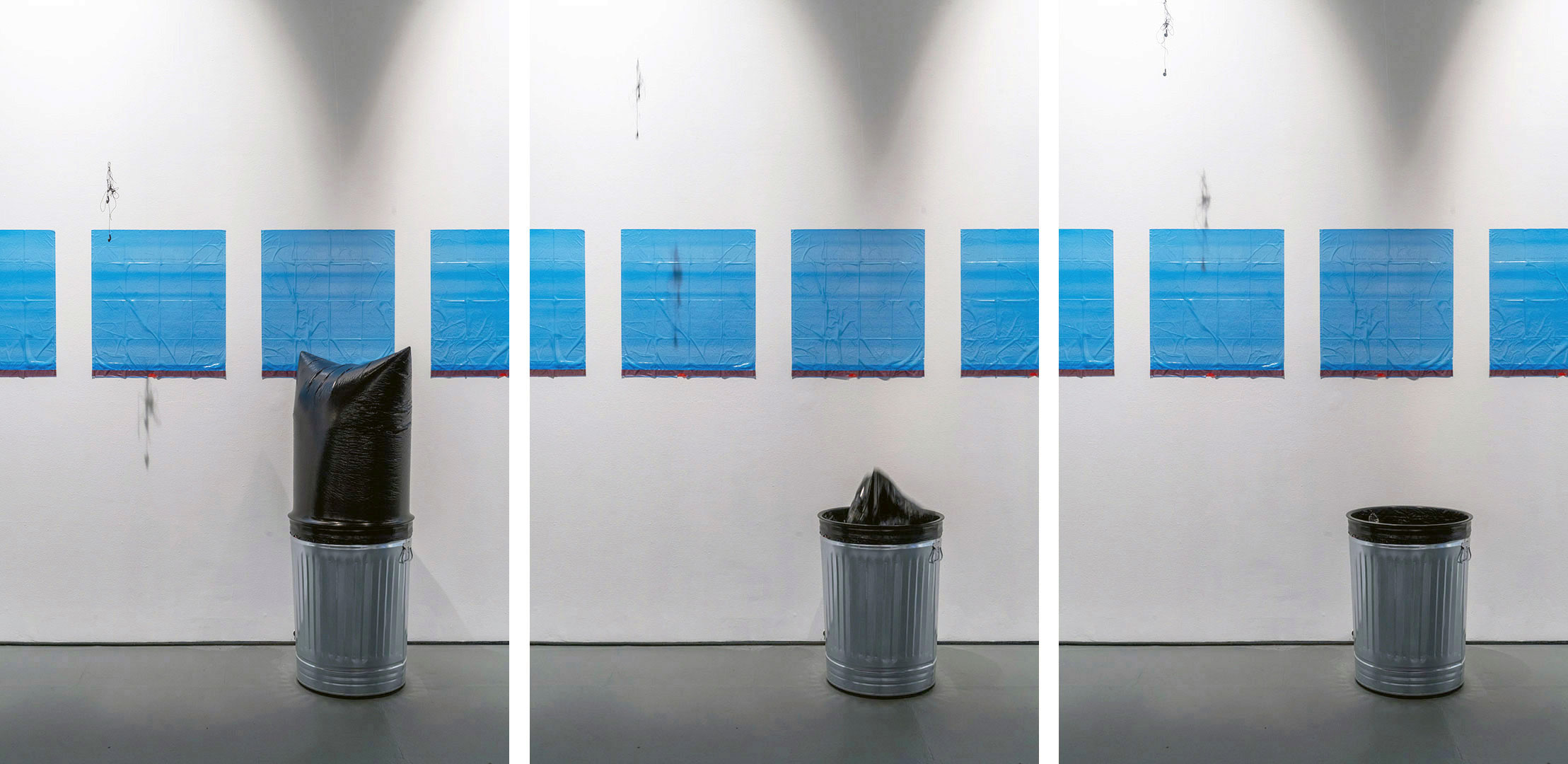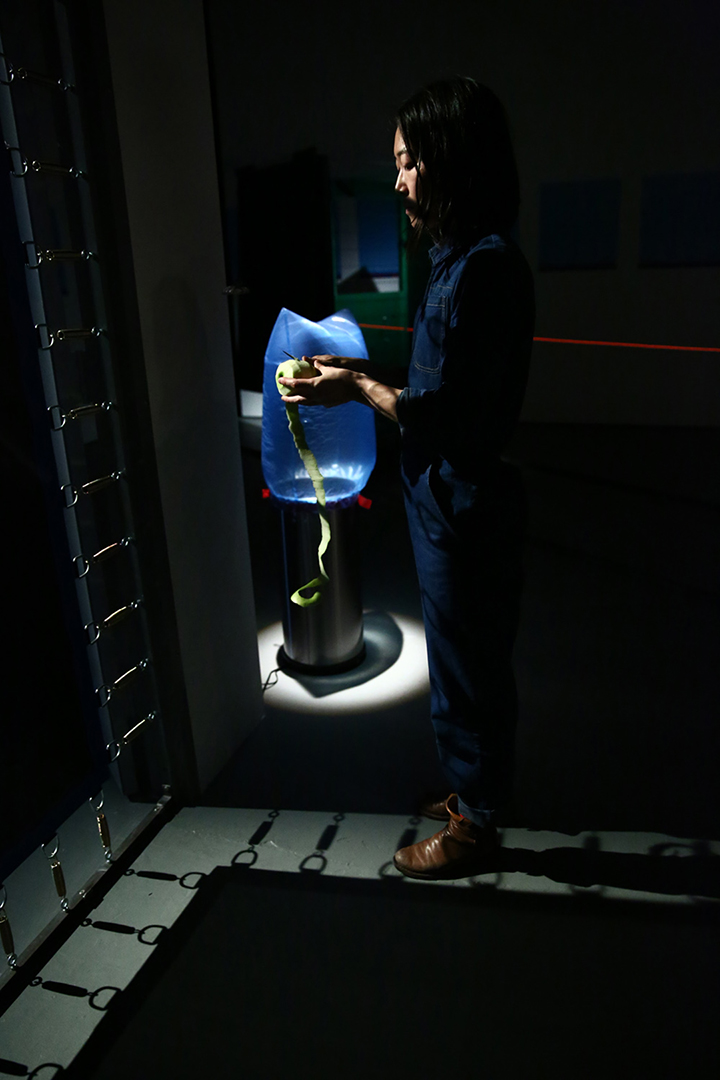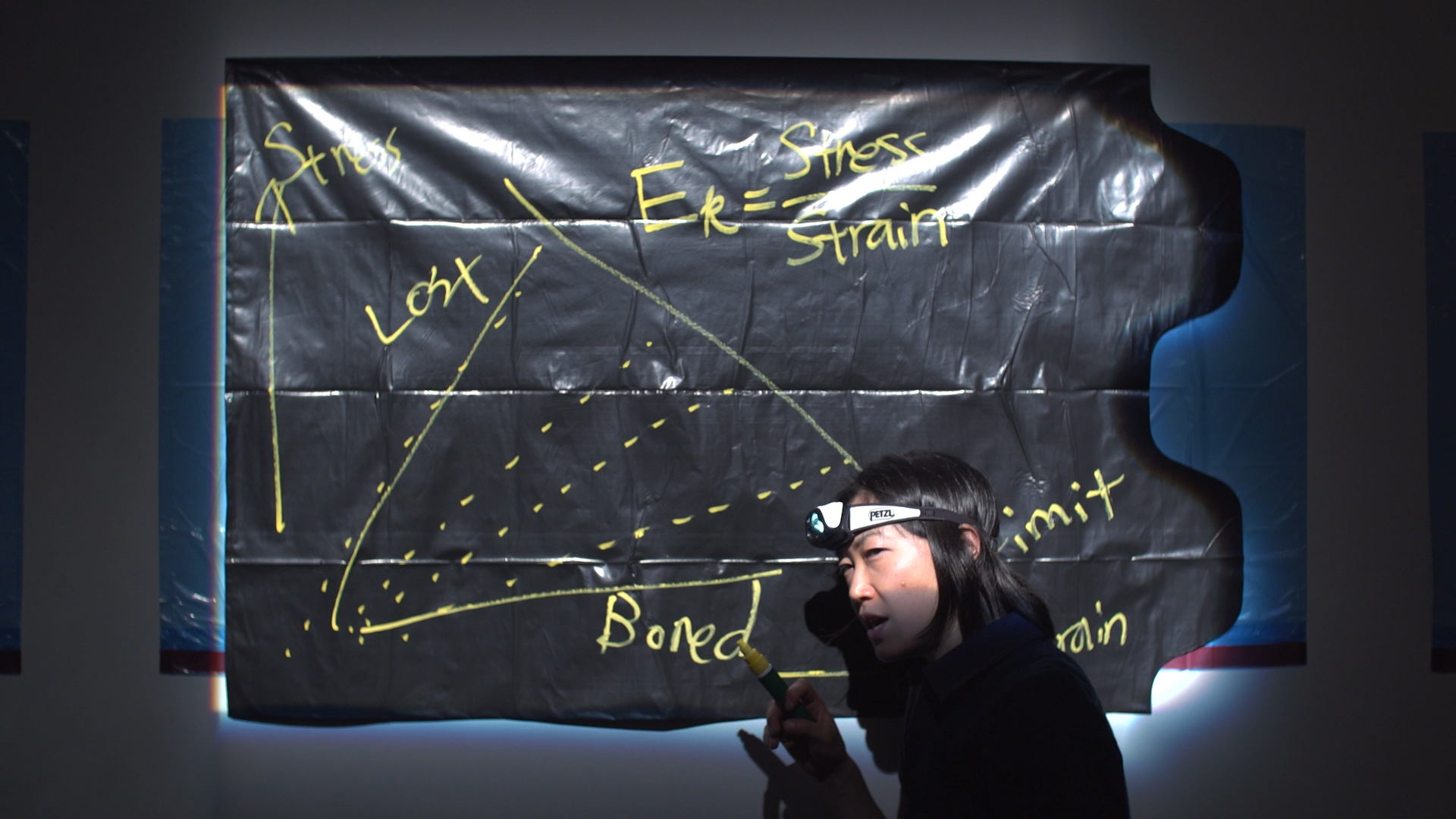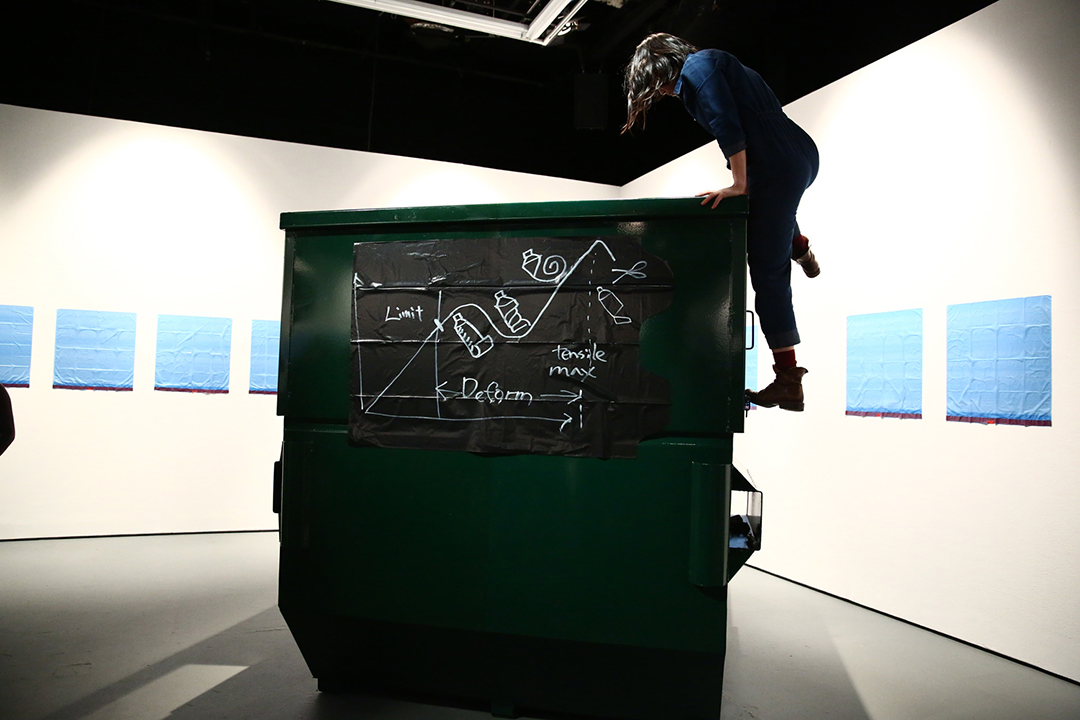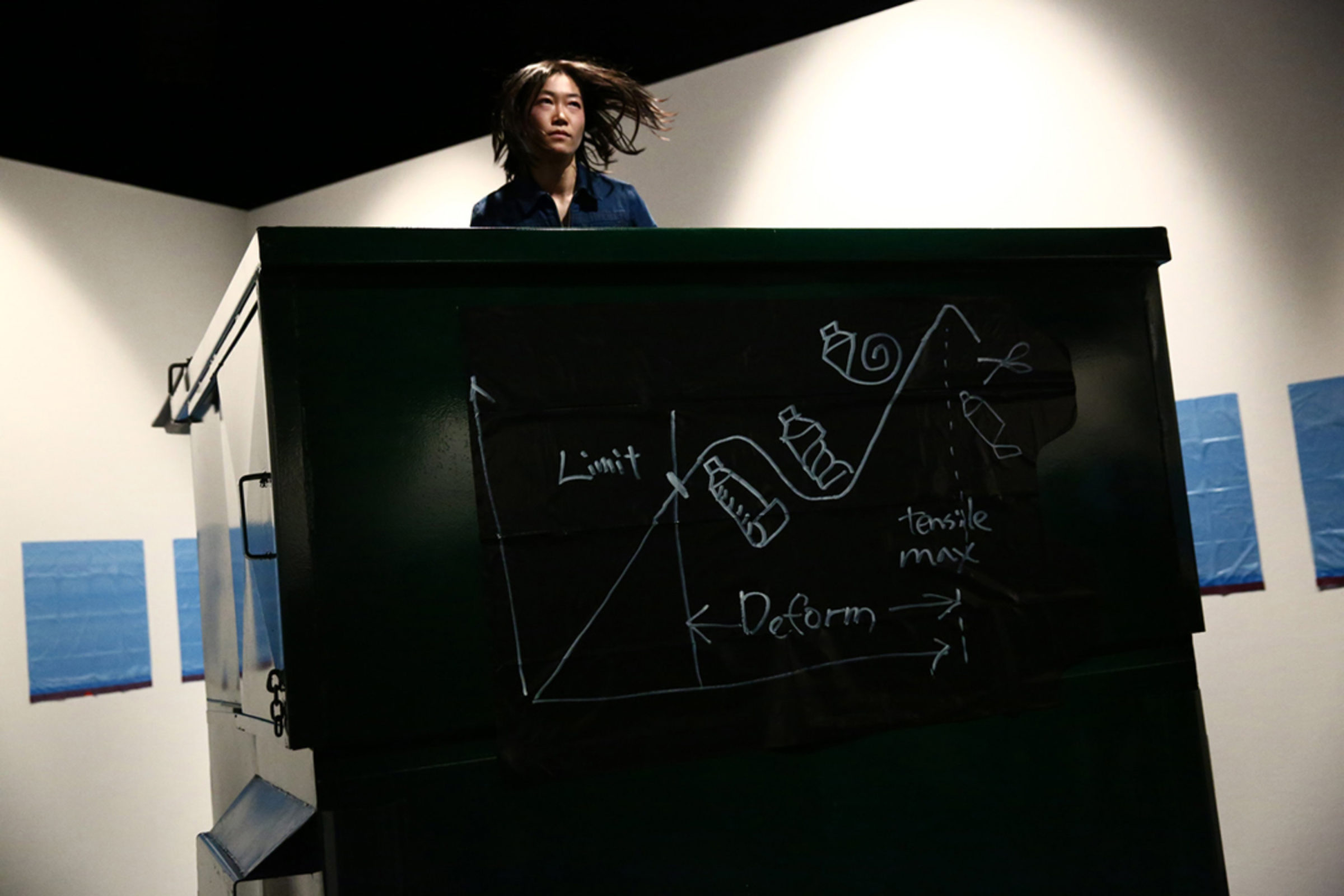笹本晃 - Yield Point
Performance
(two video projections in the adjacent room; One show the tensile testing machine sliding its arm up and down to press a steel sheet; the other the machine pulls tell and brass rods, stretching past their breaking points)
(enter the room, open the double door and pace around the room full of recycle bags held by static electricity)
I need toothpaste,
paper towels,
toilet paper,
laundry detergent,
and a light bulb.
(occasional loud snaps of steel and brass rods echo in the room)
(lighting gradually shifts to dark, with a spotlight on the vertical trampoline in the doorway)
I once read this article in the newspaper about a man, who were lost, and found in the city I lived in. This was before cellphones, and I was at the time reading this fairy tale that was similar. Intriguing.
That man claimed, according to the article, that he didn’t remember his name, where he was from, anything to do with his identity. But people researched and searched and then found out that he‘s from a distant prefecture, from the south.
I was horrified that you can be identified even though maybe he wanted to forget who he was. People said he was a man with a nice family with a kid. But maybe he just wanted to get out.
How come he can forget who he was, but remember how to walk? Or take a boat out of the southern island?
(move the split dumpster on the steel railings until they lock at the ends and tighten the piano wire between the halves by twisting the turnbuckles)
(sound of the piano wire resonating with the dumpster halves, that are locked at the edge of the steel railings)
(lighting shifts to dark again, except the red LED string glowing over the taut piano wire)
So we’ve been talking about elasticity.
Elasticity can be measured by stress over strain. You can measure most any property’s elasticity.
Most objects in this world is under the elastic limit. Being pushed and pulled but goes back to their home state.
Most incidents can be measured by the magnitude of the elastic constant.
Every person can be measured by this elastic constant.
Some people has higher elasticity. Those people tend to get lost in life.
Some people lower elasticity. Those people can get bored in life.
(get inside the split dumpster half, slide walnuts along green elastic strings to change the angle of the walnut graph)
People with low elastic constant, they tend to be lazy. They tend to get flaky. These are the people who give you an unimaginative excuse and not come to your house to hang out, once you move to an inconvenient neighborhood.
People with high elastic constant, these people tend to become slippery. Their mind is moving so fast, they can’t be grounded to even have a conversation.
The way to test your colleague’s elasticity is to send that crazy aunt who tries to sell a bogus product. People with low elasticity will freeze, and not look at her in the eyes. People with high elasticity will engage in a conversation and outperform her craziness. But sometimes the incident can go off the elastic limit and propose a different scenario. That’s what I call I-don’t-speak-English technique.
You can change the subject, you can change the object, you can change the property of the material. What happens beyond the elastic limit is not proportional.
I need toothpaste.
I needed toothpaste two weeks ago.
But It is still going somehow.
It is amazing how far you can push it past two-weeks-ago.
But I need toothpaste soon.
So what happens beyond Elastic Limit?
Most things in the world can be explained when elasticity is proportional. But beyond the limit, material starts to behave funny. This is the yield point. Sometimes you realize you have to get the toothpaste, but you keep pushing beyond the limit, when you enter into the imaginative excuse. Making all sorts of way to get the last bit of the paste. Or my favorite has a spiral. Keep pushing, till the maximum tensile strength. And you will start to destroy the material, introducing the scissors. Destruction of the material. You don’t want to go there.
How can you stay within this imaginative area, between the yield point, before the destruction? This is the plastic phase. Deformation. Change. Perhaps the lost man was staying within the imaginative excuse, here, away from home.
How elastic are you?
People with low elastic constant get bored in life.
People with high elastic constant get lost in life.
How elastic are you?
With little elasticity, you’ll be bored in life.
With high elasticity, you’ll be lost in life.
Can you go back and forth?
Back and forth,
to stay in a flex state.
How elastic are you?
Photo: Jason Mandella, Paula Court
Movie: Yield Point
Movie based on performance
Flex Test – Steel, Tensile Test – Steel/Brass
Video work screened as part of installation
Trash Bag Tensile Test
Video work screened as part of installation
Installation
Information
A split dumpster is pulled apart and moves along steel rails. The wire between the dumpster halves hums with sonic feedback. A handmade trampoline is stretched inside of a second dumpster. Steel double doors also house the fitted trampoline but vertically. Trash bags are held up on walls by static electricity. Video projections are of the tensile testing machine stretching materials and sound of occasional snaps echo throughout the space. The installation comes alive even without the presence of a performer- the lights are programmed to continuously accent a drama of animatronic sculptures and a few garbage cans inflate and deflate their bags with wind.
Collection The National Museum of Art, Osaka
Exhibition History
- 2017
-
“Aki Sasamoto: Yield Point,” commissioned by The Kitchen, New York
“Sequences VIII: Elastic Hours,” Reykjavík Art Museum, Reykjavík
- 2018
-
“Travellers: Stepping into the Unknown,” The National Museum of Art, Osaka


